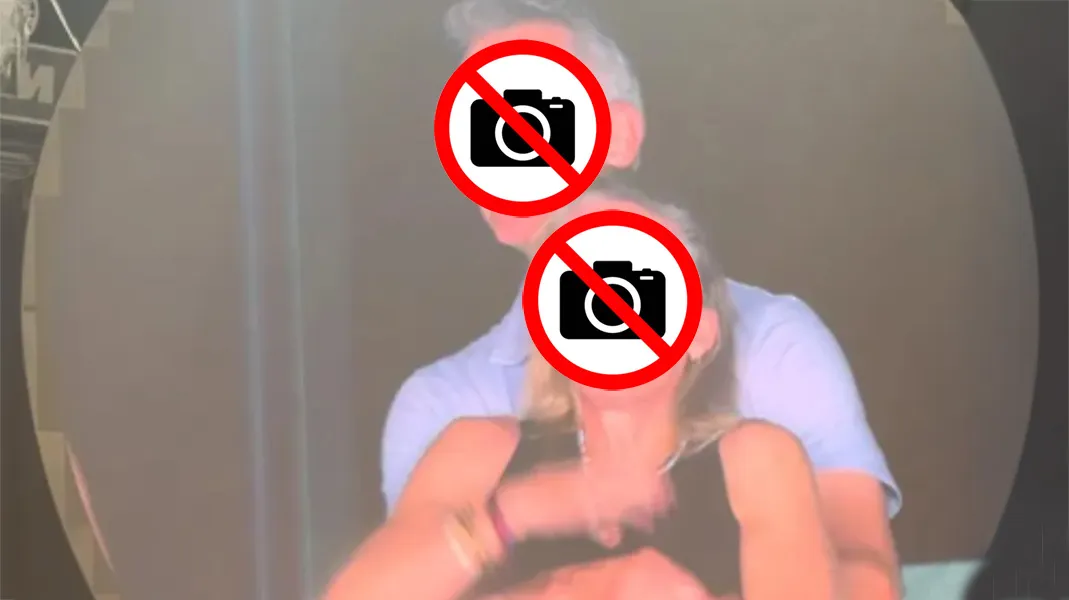Last week, that now-infamous Coldplay concert clip, where a “Kiss Cam” moment spiraled into global speculation, sparked a wave of reactions. I shared some thoughts on the ethics of being photographed in public and noticed that many of the responses came down to: “Well, it’s the law” or “When you buy a ticket, you should know.”
This follow-up is about asking whether the laws and practices we’ve normalized still make sense in a world where tech moves faster than consent.

Kiss Cam, Coldplay concert – July 17, 2025.
Original clip: author unknown, rights status: public(?).
Remixed by Laura Abad, with consent in question.
It used to be simple: if you walked into a stadium, attended a concert, or showed up at a rally, you might see a sign saying your image could be captured. Maybe it was printed on the back of your ticket. Maybe you didn’t even notice it. And honestly, it didn’t seem like a big deal.
But now, a blurry phone clip can rocket around the world in seconds. A spontaneous expression, a shared glance, or a casual gesture can be re-edited, memefied, dissected, and judged by millions.
We’re no longer just dealing with the idea of being seen. We’re dealing with the reality of being consumed.
In the U.S., public photography and filming are largely protected under First Amendment rights. If you're in a public place, you can be recorded. Venues often reinforce this with ticket disclaimers and signage, legally framing attendance as consent. This includes allowing third-party filming, broadcasting, and content reuse with almost no limitations.
The GDPR introduced stricter boundaries around personal data, including identifiable images. While personal photography in public spaces is allowed, publishing those images often requires consent. Countries like Germany, Denmark, and Greece have reinforced individual rights over their likeness, even in public settings.
South Korea has some of the world’s most stringent visual privacy laws. Taking a photo of someone's face in public without consent can be considered a criminal offense. There are specific laws targeting unauthorized photography, especially when it involves the possibility of sexual harassment or defamation. The country’s robust legal framework reflects its broader cultural emphasis on personal dignity and strict boundaries around image rights.
In countries such as Nigeria and Kenya, public photography is generally legal, but concerns around consent and ethical use are growing. Unauthorized use, especially for commercial or defamatory purposes, can be contested. Local digital rights organizations are advocating for clearer privacy regulations that reflect the realities of mobile photography and viral sharing.
Laws across South Asia vary widely. In India, public photography is generally permitted, but legal action can be taken under defamation, harassment, or privacy claims. In countries like Sri Lanka and Bangladesh, protections are less clearly defined, though advocacy is increasing. Pakistan has begun exploring new digital rights legislation, including proposals for consent-based visual regulation in public zones.
Enforcement across these regions remains inconsistent, and public awareness of rights is often low. But as mobile use and social media platforms grow, so does the urgency to rethink ethical norms around visual consent.
The problem isn’t that people don’t know they might be filmed. It’s that the implications of that recording have changed dramatically. What used to stay within the venue now lives online, forever searchable, remixable, and repurposable.
Yet the rules haven’t evolved. Ticket disclaimers may legally cover a venue. But ethically, is it still enough?
Can a clause printed in fine print at the bottom of your event ticket justify being turned into a meme or the target of global scrutiny?
Having worked over a decade in concert promotion, I’ve seen firsthand how these environments are designed to elicit euphoria. People let their guard down. They dance, kiss, laugh, cry. And they do so in the belief that the moment is theirs. But with every phone raised, that moment risks being turned into something else entirely. Something viral.
So maybe the conversation isn’t just about what's legal. Maybe it’s about whether the frameworks we’ve normalized still serve us.
Because the truth is, most people don’t focus on those disclaimers. Most aren’t aware that showing up means surrendering their likeness. And even fewer know how their image might be used, scraped, stored, or analyzed by third-party AI systems (a topic for another day).
Laura Abad Guerrero, Marketing Lead at Fairpicture
We need a cultural and technological shift that:
One step in this direction is FairConsent by Fairpicture, a framework and toolset built to align visual storytelling with dignity and transparency. Especially in jurisdictions where laws are evolving to restrict the public depiction of individuals without explicit consent, solutions like FairConsent offer a way forward. Instead of relying on vague disclaimers or default permissions, it promotes active, informed agreement that adapts to both legal requirements and human rights.
The legal system may not change overnight. But we can start by reimagining the standards we accept. Because attending a concert shouldn’t mean becoming unintentional content.
And just because it's printed on a ticket, doesn't mean it's fair.